 System Tutorial
System Tutorial
 LINUX
LINUX
 The impact of an enterprise's organizational structure on its technical architecture
The impact of an enterprise's organizational structure on its technical architecture
The impact of an enterprise's organizational structure on its technical architecture
| Introduction | Technical personnel often have a tendency to focus on digging coal (working on technical architecture) without understanding the context of coal mining (the business background and organizational structure of the company). They do not know the organizational structure, business background and technology of the company. There is an implicit mapping relationship between architectures, and this relationship sometimes directly determines the success or failure of technical architecture transformation. |
This article attempts to establish this contextual background for technical personnel (especially architects), improve the technical personnel's vision, and allow technical personnel to promote the improvement and upgrading of the system architecture on the premise of understanding the enterprise's business background and organizational structure, with a view to Be more successful.
Economic BackgroundThe picture below is called the bathtub curve, which comes from Niels Pflaeging's book "Organize for Complexity" [Appendix 2]. It mainly reflects the changes in the Western economic model from the last century to the present. The shape looks like a bathtub, hence the name.
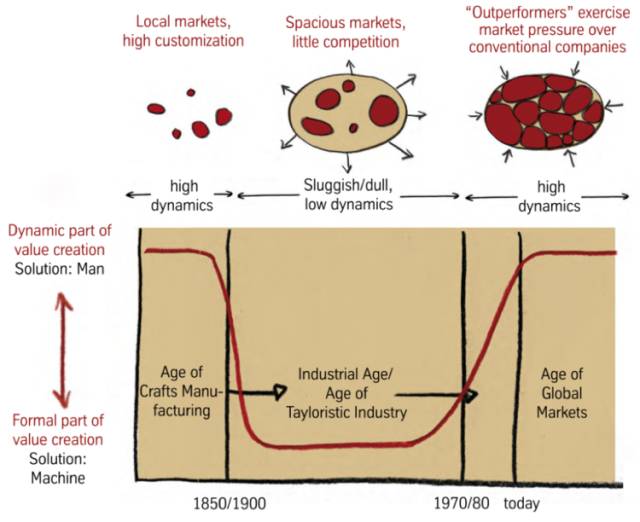
- The period before 1900 was called the pre-industrial era, also known as the handicraft era. The main body of value creation in this era was craftsmen who mastered skills. Highly dynamic, localized markets, and customization were the main characteristics of the market in this era.
- The period from 1900 to 1980 is known as the Taylor Industrial Age. The main body of value creation in this era was machines. The market was vast and slow, with little competition. Improving efficiency and competing for low costs through mechanization and large-scale production were the main focus of the market in this era. Features.
- 1980 is now called the post-industrial era, also known as the global economic era. The main body of value creation in this era is knowledge workers. Emerging industries continue to exert competitive pressure on traditional industries. They are highly dynamic and continue to respond quickly to market demand. The key to success in this era of markets.
The organizational structure cannot be simply designed by the leadership. Different economic models require different organizational structure support. There is an implicit mapping relationship between the organizational structure and the economic model.
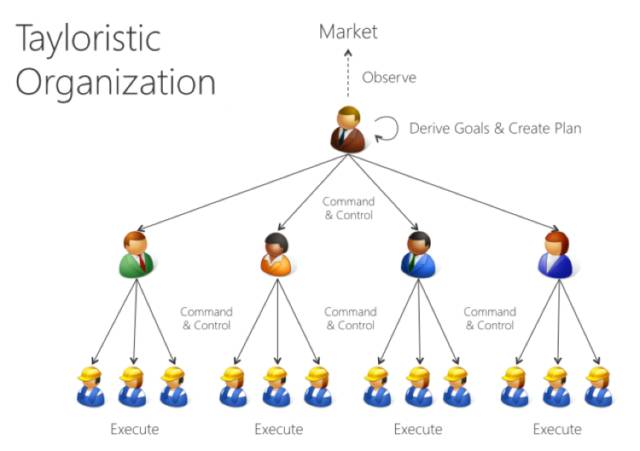
The picture above is the mainstream Taylor-type organizational structure in the Taylor Industrial Era, also known as the Command & Control organization. The leadership of the organization observes the market and formulates target plans, which are passed down by middle-level managers and implemented by lower-level employees.
The advantages, disadvantages and suitable scenarios of this organizational structure are as follows:
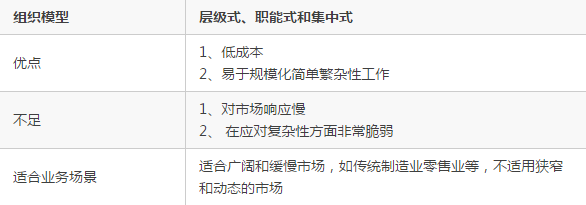
The Taylor Industrial Age lasted for more than a century and had a profound impact on our society. Even today, Taylor-type organizations are still the mainstream organizational structure of various enterprises in our society.
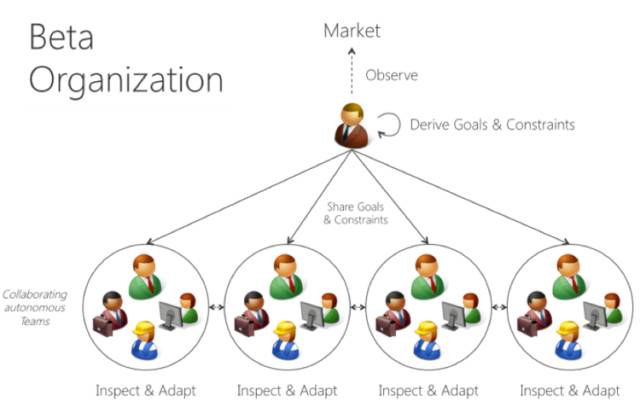
The picture above is a beta-type organization that is gradually emerging in the post-industrial era. It is common in some emerging industries such as mutual benefit network business companies. This type of organization still has leaders who focus on observing the market and formulating shared goals and constraints, but the organizational structure is relatively flat and the team organization favors cross-functional mixing and collaboration to respond quickly to market changes.
The advantages, disadvantages and suitable scenarios of this organizational structure are as follows:

Beta-type organizations are a model of modern leadership models and the direction of learning and transformation for many, especially traditional companies.
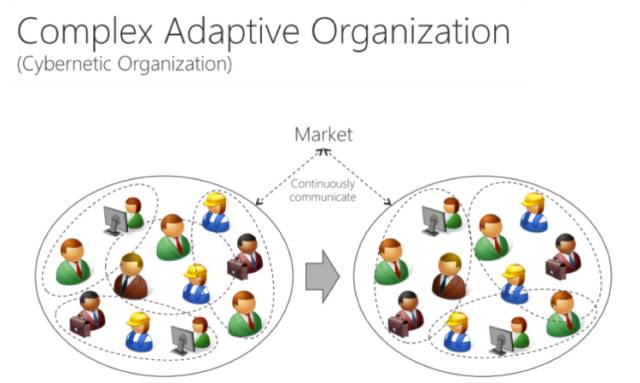
The complex adaptive organizational structure in the picture above, also known as the control feedback organizational structure (Cybernetic Organization), is currently relatively rare among established companies (only seen in a few startups), but it is a new trend in future organizational structures. This structure does not have centralized goal setting. The cross-functional mixed and collaborative team directly connects with the market, continuously communicates with the market to obtain needs, and responds quickly and flexibly to market changes.
The advantages, disadvantages and suitable scenarios of this organizational structure are as follows:

Mel Conway proposed the so-called Conway's Law [Appendix 3] in 1967, which pointed out that there is an implicit mapping relationship between organizational structure and system architecture:
Organization which design systems […] are constrained to produce designs which are copies of the communication structures of these organizations.
The design of the organization of the design system is equivalent to the communication structure between organizations
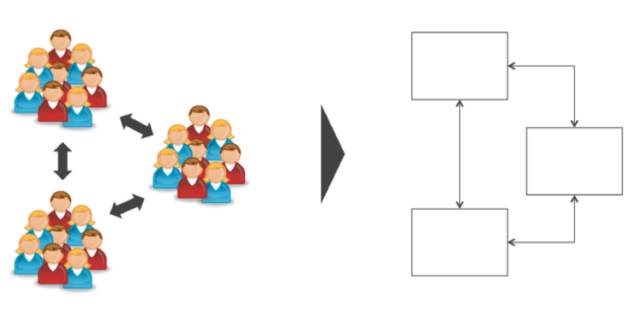
Conway's law can also be stated in reverse:
Conway’s law reversed: You won’t be able to successfully establish an efficient organization structure that is not supported by your system design(architecture).
You cannot build an efficient organizational structure if your system architecture does not support it. You can't build an efficient system architecture if your organizational structure doesn't support it.
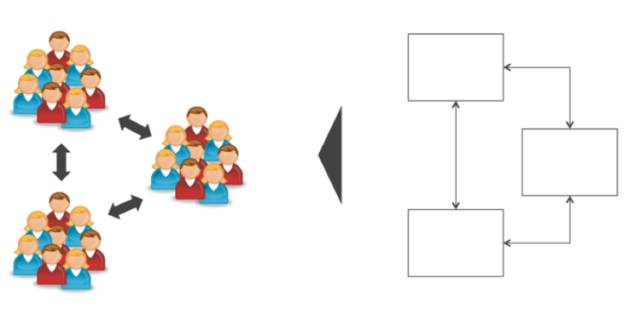
Conway's Law gives us a good inspiration. There is an implicit mapping relationship between system architecture and organizational structure. You cannot unilaterally change the structure of one side, and both sides must be linked when adjusting. As shown in the figure below, if the system architecture is monolithically coupled, it will be difficult to organize a decentralized cross-functional market-oriented team structure. The two sides cannot be mapped, and friction and fights between teams are inevitable. Therefore, we generally first decouple and split individual applications according to business line boundaries, and at the same time make corresponding organizational structural adjustments. This is the motivation behind the microservice architecture that has become popular in recent years.
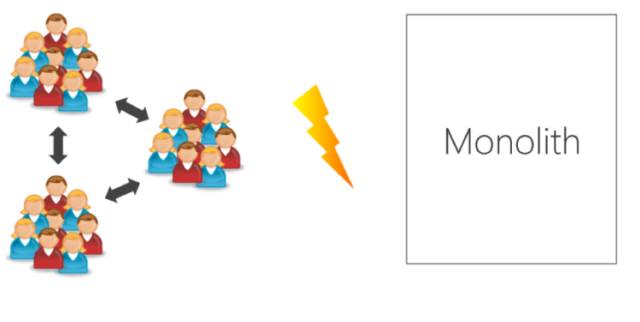
Technical architecture cannot exist and be designed unilaterally independently. It has an implicit mapping relationship with the organizational structure and supports the core driving elements of the organization. The following two figures respectively illustrate the core architecture driving elements of Taylor-type organizations and complex adaptive organizations, as well as the resulting application architecture characteristics.
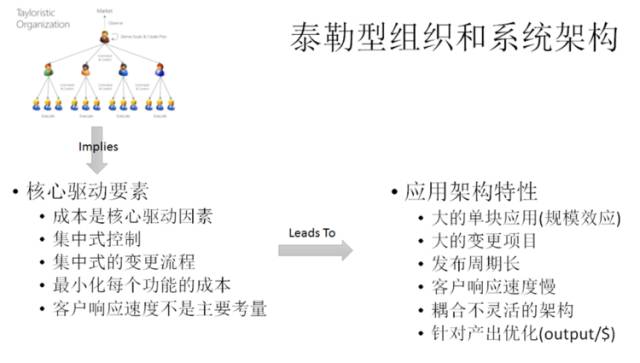
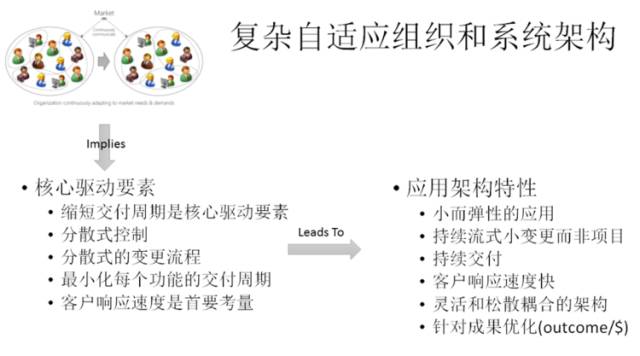
From the technology stack and application architecture characteristics adopted by an organization, you can also quickly infer the organization's business model and organizational structure, as shown in the figure below. Monolithic architecture, centralized database, and layered architecture are common in Taylor-type organizations; while cloud computing, REST microservices, and DevOps technologies are common in Beta and complex adaptive organizations. The figure below also reflects the synchronous evolution trend of organizational structure and technology stack.
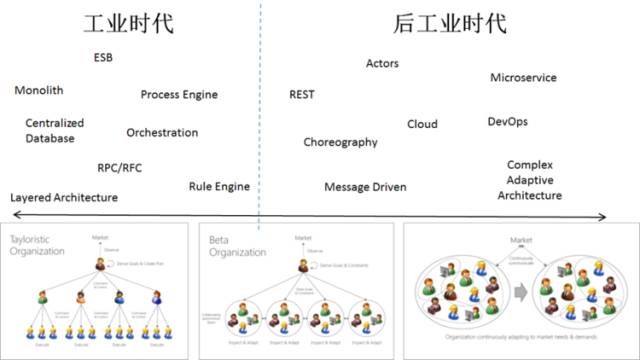
- We have entered the post-industrial era, and organizations need to adjust their structures to adapt to new market changes. Complex adaptive architecture is the evolutionary trend of future organizational architecture.
- There is an implicit mapping relationship between the market, organizational structure, system architecture and technology, which cannot be simply designed and unilaterally adjusted. Qualified architects must have insight into this mapping relationship, systematically and flexibly promote organizational and system architecture adjustments based on market and organizational status quo, align enterprise business, organization and technology, and respond to market changes more agilely.
- Without changing the enterprise's organizational structure and management culture, it is difficult to unilaterally change the enterprise's technical architecture. In the end, the technical architecture will be constrained by the strong organizational structure and enterprise management culture, reflecting the enterprise's management culture and organizational structure. (This article does not talk about corporate management culture, but corporate management culture is also crucial to corporate architecture).
- In the digital transformation of an enterprise, the adjustment of the system architecture and the enterprise's organization and management culture must be carried out simultaneously, and the key is the transformation of the enterprise's organizational and management culture structure.
The above is the detailed content of The impact of an enterprise's organizational structure on its technical architecture. For more information, please follow other related articles on the PHP Chinese website!

Hot AI Tools

Undresser.AI Undress
AI-powered app for creating realistic nude photos

AI Clothes Remover
Online AI tool for removing clothes from photos.

Undress AI Tool
Undress images for free

Clothoff.io
AI clothes remover

AI Hentai Generator
Generate AI Hentai for free.

Hot Article

Hot Tools

Notepad++7.3.1
Easy-to-use and free code editor

SublimeText3 Chinese version
Chinese version, very easy to use

Zend Studio 13.0.1
Powerful PHP integrated development environment

Dreamweaver CS6
Visual web development tools

SublimeText3 Mac version
God-level code editing software (SublimeText3)

Hot Topics
 1377
1377
 52
52
 Unable to log in to mysql as root
Apr 08, 2025 pm 04:54 PM
Unable to log in to mysql as root
Apr 08, 2025 pm 04:54 PM
The main reasons why you cannot log in to MySQL as root are permission problems, configuration file errors, password inconsistent, socket file problems, or firewall interception. The solution includes: check whether the bind-address parameter in the configuration file is configured correctly. Check whether the root user permissions have been modified or deleted and reset. Verify that the password is accurate, including case and special characters. Check socket file permission settings and paths. Check that the firewall blocks connections to the MySQL server.
 C language conditional compilation: a detailed guide for beginners to practical applications
Apr 04, 2025 am 10:48 AM
C language conditional compilation: a detailed guide for beginners to practical applications
Apr 04, 2025 am 10:48 AM
C language conditional compilation is a mechanism for selectively compiling code blocks based on compile-time conditions. The introductory methods include: using #if and #else directives to select code blocks based on conditions. Commonly used conditional expressions include STDC, _WIN32 and linux. Practical case: Print different messages according to the operating system. Use different data types according to the number of digits of the system. Different header files are supported according to the compiler. Conditional compilation enhances the portability and flexibility of the code, making it adaptable to compiler, operating system, and CPU architecture changes.
 What are the 5 basic components of Linux?
Apr 06, 2025 am 12:05 AM
What are the 5 basic components of Linux?
Apr 06, 2025 am 12:05 AM
The five basic components of Linux are: 1. The kernel, managing hardware resources; 2. The system library, providing functions and services; 3. Shell, the interface for users to interact with the system; 4. The file system, storing and organizing data; 5. Applications, using system resources to implement functions.
 How to solve mysql cannot be started
Apr 08, 2025 pm 02:21 PM
How to solve mysql cannot be started
Apr 08, 2025 pm 02:21 PM
There are many reasons why MySQL startup fails, and it can be diagnosed by checking the error log. Common causes include port conflicts (check port occupancy and modify configuration), permission issues (check service running user permissions), configuration file errors (check parameter settings), data directory corruption (restore data or rebuild table space), InnoDB table space issues (check ibdata1 files), plug-in loading failure (check error log). When solving problems, you should analyze them based on the error log, find the root cause of the problem, and develop the habit of backing up data regularly to prevent and solve problems.
 Can mysql run on android
Apr 08, 2025 pm 05:03 PM
Can mysql run on android
Apr 08, 2025 pm 05:03 PM
MySQL cannot run directly on Android, but it can be implemented indirectly by using the following methods: using the lightweight database SQLite, which is built on the Android system, does not require a separate server, and has a small resource usage, which is very suitable for mobile device applications. Remotely connect to the MySQL server and connect to the MySQL database on the remote server through the network for data reading and writing, but there are disadvantages such as strong network dependencies, security issues and server costs.
 Solutions to the errors reported by MySQL on a specific system version
Apr 08, 2025 am 11:54 AM
Solutions to the errors reported by MySQL on a specific system version
Apr 08, 2025 am 11:54 AM
The solution to MySQL installation error is: 1. Carefully check the system environment to ensure that the MySQL dependency library requirements are met. Different operating systems and version requirements are different; 2. Carefully read the error message and take corresponding measures according to prompts (such as missing library files or insufficient permissions), such as installing dependencies or using sudo commands; 3. If necessary, try to install the source code and carefully check the compilation log, but this requires a certain amount of Linux knowledge and experience. The key to ultimately solving the problem is to carefully check the system environment and error information, and refer to the official documents.
 MySQL can't be installed after downloading
Apr 08, 2025 am 11:24 AM
MySQL can't be installed after downloading
Apr 08, 2025 am 11:24 AM
The main reasons for MySQL installation failure are: 1. Permission issues, you need to run as an administrator or use the sudo command; 2. Dependencies are missing, and you need to install relevant development packages; 3. Port conflicts, you need to close the program that occupies port 3306 or modify the configuration file; 4. The installation package is corrupt, you need to download and verify the integrity; 5. The environment variable is incorrectly configured, and the environment variables must be correctly configured according to the operating system. Solve these problems and carefully check each step to successfully install MySQL.
 How to solve the problem of missing dependencies when installing MySQL
Apr 08, 2025 pm 12:00 PM
How to solve the problem of missing dependencies when installing MySQL
Apr 08, 2025 pm 12:00 PM
MySQL installation failure is usually caused by the lack of dependencies. Solution: 1. Use system package manager (such as Linux apt, yum or dnf, Windows VisualC Redistributable) to install the missing dependency libraries, such as sudoaptinstalllibmysqlclient-dev; 2. Carefully check the error information and solve complex dependencies one by one; 3. Ensure that the package manager source is configured correctly and can access the network; 4. For Windows, download and install the necessary runtime libraries. Developing the habit of reading official documents and making good use of search engines can effectively solve problems.



